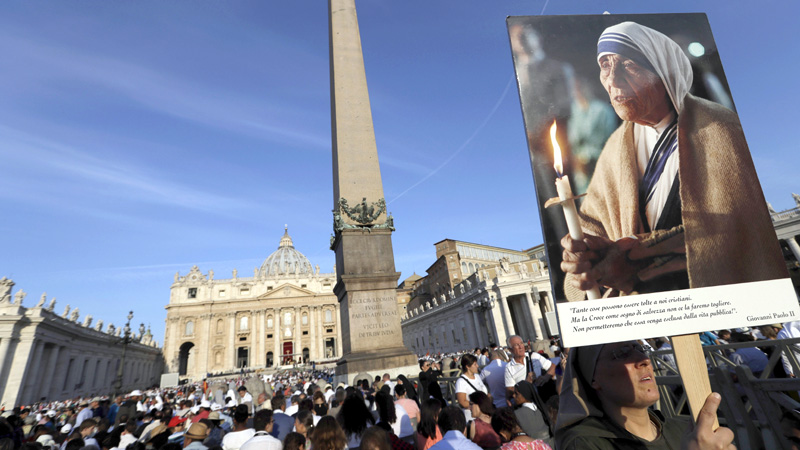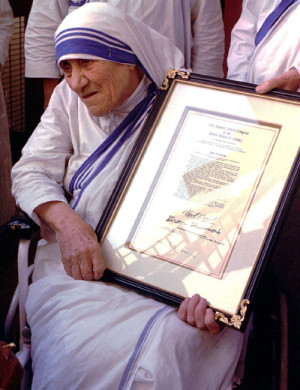Pope Francis hails St. Teresa a model of mercy
VATICAN CITY—Pope Francis declared Mother Teresa a saint on Sunday, honoring the tiny nun for having taken in society’s most unwanted and for having shamed world leaders for the “crimes of poverty they themselves created.”
Francis held up Mother Teresa as the model for a Catholic Church that goes to the peripheries to find poor, wounded souls during a canonization Mass that drew an estimated 120,000 people—rich and poor, powerful and homeless—to a sun-filled St. Peter’s Square.
Applause erupted in the square even before Francis finished pronouncing the rite of canonization at the start of the Mass, evidence of the admiration Mother Teresa enjoyed from Christians and non-Christians alike.
“For the honor of the Blessed Trinity … we declare and define Blessed Teresa of Kolkata to be a saint and we enroll her among the saints, decreeing that she is to be venerated as such by the whole Church,” the Pope said in Latin.
Speaking from the steps of St. Peter’s Basilica, Francis said that even though the nun had been declared a saint, she would always be Mother Teresa to the Catholic family.
He admitted even he would find it hard to call her “St. Teresa” since her kindness was so maternal.
Article continues after this advertisementEchoing his own vision of a “poor church for the poor,” he described Mother Teresa’s work as “eloquent witness to God’s closeness to the poorest of the poor.”
Article continues after this advertisementSmile in our hearts
To applause, he added: “Mother Teresa loved to say, ‘Perhaps I don’t speak their language but I can smile.’”
“Let us carry her smile in our hearts and give it to those whom we meet along our journey, especially those who suffer,” he said.
Francis also used his sermon to recall Mother Teresa’s fervent opposition to abortion, which she termed “murder by the mother” in a controversial Nobel Peace Prize speech in 1979.
She shamed leaders
Francis said Mother Teresa spent her life “bowing down before those who were spent, left to die on the side of the road, seeing in them their God-given dignity.”
He added: “She made her voice heard before the powers of the world, so that they might recognize their guilt for the crimes of poverty they themselves created.”

SAINTHOOD RITES A photo of Mother Teresa rises among the thousands of pilgrims who thronged to St. Peter’s Square on Sunday for her canonization. The nun is remembered for her mercy in caring for the world’s most unwanted. AP
As if to emphasize the point, Francis repeated the “the crimes of poverty they themselves created.”
The ceremony came a day before the 19th anniversary of Mother Teresa’s death in Kolkata, the Indian city where the nun spent nearly four decades working in wretched slums.
For Francis, Mother Teresa put into action his ideal of the Church as a merciful “field hospital” for the poorest of the poor, those suffering both material and spiritual poverty.
By canonizing her during his Jubilee Year of Mercy, Francis in some ways is making her the icon of his entire pontificate.
Security fears
Hundreds of Missionaries of Charity sisters in their trademark blue-trimmed saris had front-row seats at the Mass, sitting under a searing hot sun and blue skies alongside 1,500 homeless people and 13 heads of state or government, including Queen Sofia of Spain.
“Her heart, she gave it to the world,” said Charlotte Samba, a 52-year-old mother of three who traveled with a church group from Gabon for the Mass. “Mercy, forgiveness, good works: It is the heart of a mother for the poor.”
While big, the crowds were not as large as the 300,000 who turned out for Mother Teresa’s 2003 beatification, thanks in part to security fears in the wake of Islamic extremist attacks in Europe.

In this Saturday, Nov. 16, 1996 file photo, Mother Teresa holds the resolutions of honorary American citizenship after they were presented to her by American Ambassador to India Frank G. Wisner at the Missionaries of Charity in KolKata, formerly known as Calcutta, India. With Sunday, Sept. 4, 2016 making the canonization of Mother Teresa, Pope Francis honored the tiny nun who cared for the “poorest of the poor” as the epitome of his call for mercy. Here are some significant dates in the life of the Catholic Church’s newest saint. (AP Photo, File)
Those fears prompted a huge, 3,000-strong law enforcement presence to secure the area around the Vatican and close the airspace above.
Nevertheless, those on hand were jubilant to have made the journey—nuns, priests, volunteers, pilgrims and tourists clutching the coveted 100,000 tickets issued for the Mass.
One group of 40 Indian nationals traveled from Macerata, Italy, to honor a woman given India’s highest civilian and humanitarian awards for her work in the slums of Kolkata.
Another group of 100 drove from Kosovo toting a banner that read: “Mother Teresa: Pray for Us.”
While Francis is clearly keen to hold Mother Teresa up as a model for her joyful dedication to society’s outcasts, he is also recognizing holiness in a nun who lived most of her adult life in spiritual agony sensing that God had abandoned her.
‘Dark night of soul’
According to correspondence that came to light after she died in 1997, Mother Teresa experienced what the Church calls a “dark night of the soul”—a period of spiritual doubt, despair and loneliness that many of the great mystics experienced.
In Mother Teresa’s case, it lasted for nearly 50 years—an almost unheard of trial.
For the Rev. Brian Kolodiejchuk, the Canadian priest who spearheaded Mother Teresa’s saint-making campaign, the revelations were further confirmation of Mother Teresa’s heroic saintliness.
He said that by canonizing her, Francis is recognizing that Mother Teresa not only shared the material poverty of the poor but the spiritual poverty of those who feel “unloved, unwanted, uncared for.”
“What she described as the greatest poverty in the world today (of feeling unloved) she herself was living in relationship with Jesus,” he said in an interview on the eve of the canonization.
Francis has in many ways modeled his papacy on Mother Teresa’s simple lifestyle and selfless service to the poor: He eschewed the Apostolic Palace for a hotel room, he has made welcoming migrants and the poor a hallmark and has fiercely denounced today’s “throwaway” culture that discards the unborn, the sick and the elderly with ease.

Pope Francis talks with a nun of the Sisters of the Missionaries of Charity as he leaves at the end of the Canonization Mass of Mother Teresa in St. Peter’s Square, at the Vatican, Sunday, Sept. 4, 2016. Francis has declared Mother Teresa a saint, honoring the tiny nun who cared for the world’s most destitute as an icon for a Catholic Church that goes to the peripheries to find poor, wounded souls. (AP Photo/Gregorio Borgia)
In keeping with her spirit, he treated 1,500 homeless people bussed into Rome for the Mass to a pizza lunch in the Vatican auditorium after the Mass.
‘Call within a call’
Born Agnes Gonxhe Bojaxhiu on Aug. 26, 1910, Mother Teresa came to India in 1929 as a sister of the Loreto order.
In 1946, she received what she described as a “call within a call” to found a new order dedicated to caring for the most unloved and unwanted, the “poorest of the poor.”
In 1950, she founded the Missionaries of Charity, which went onto become a global order of nuns—identified by their trademark blue-trimmed saris—as well as priests, brothers and lay coworkers.
She was awarded the Nobel Peace Prize in 1979.
She died in 1997 after a lifetime spent caring for hundreds of thousands of destitute and homeless poor in Kolkata, for which she came to be called the “saint of the gutters.”
St. John Paul II, her most ardent supporter, fast-tracked her for sainthood and beatified her before a crowd of 300,000 in 2003. Reports from AP and AFP